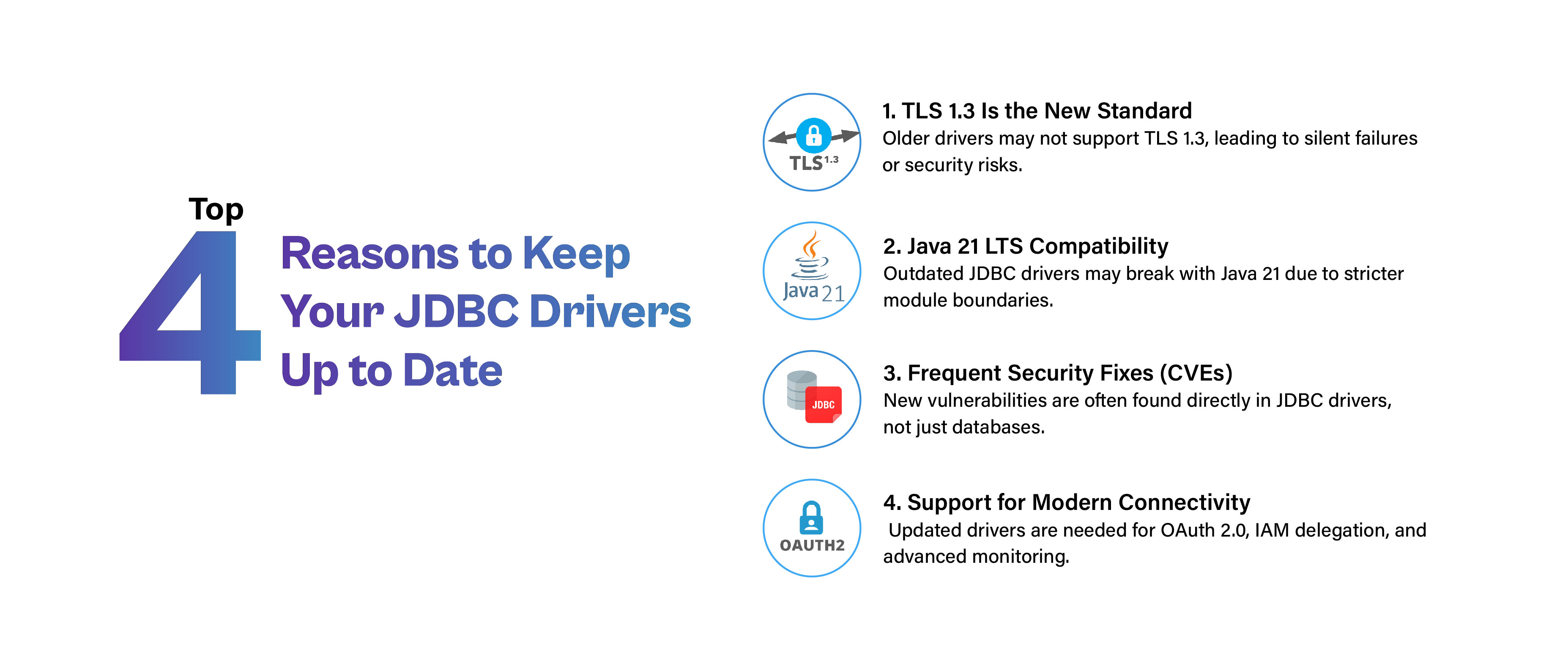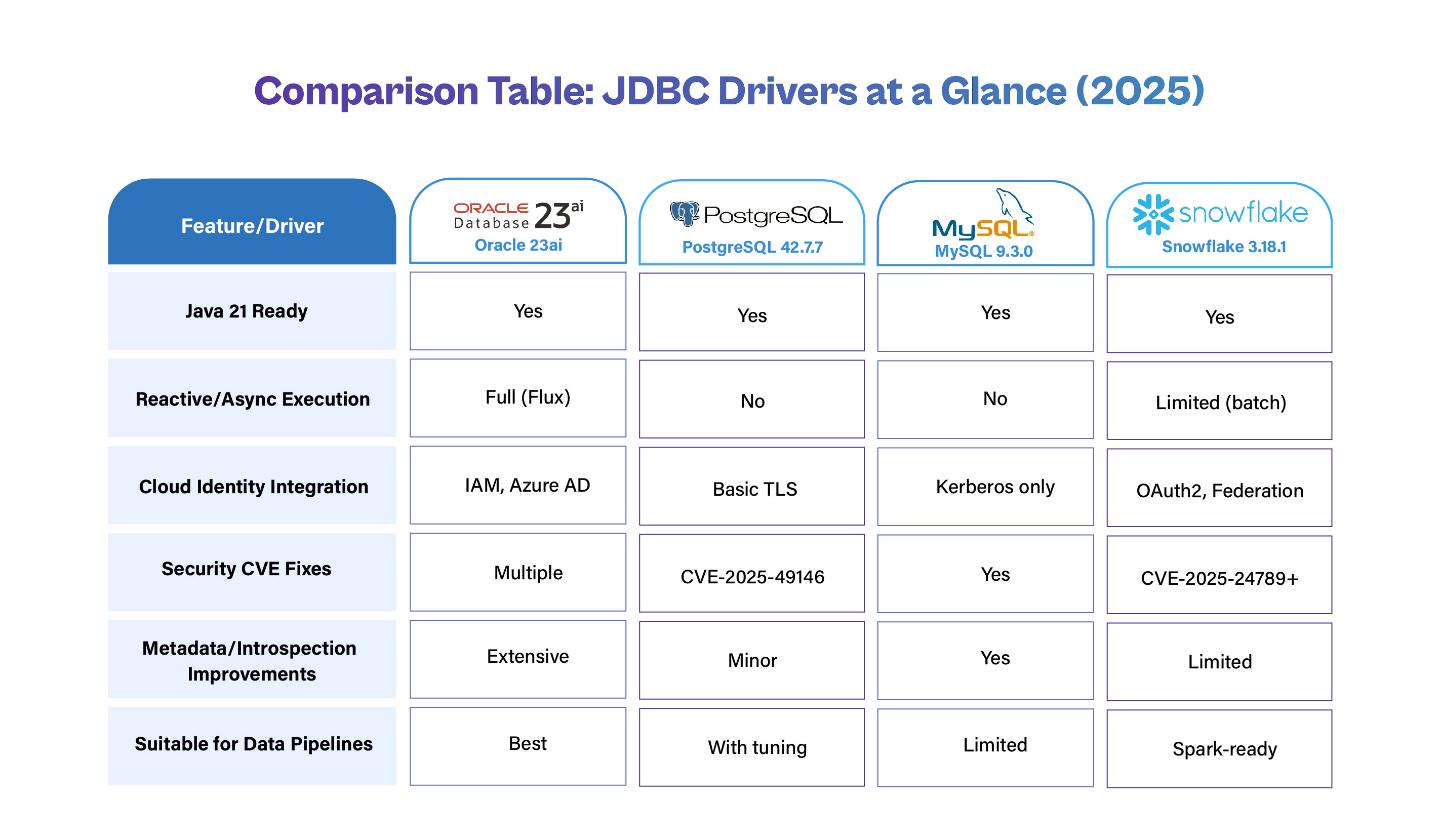




For Java architects, DB-administrators, and platform engineers, the timely update of JDBC drivers in 2025 is not merely a procedural task; it is a foundational imperative for ensuring the security, performance, and future viability of enterprise Java applications. Neglecting these updates poses a direct risk, exposing systems to identifiable vulnerabilities and suboptimal resource utilization.
The current technological landscape, characterized by significant advancements in platform standards, communication protocols, and security paradigms, underscores the critical importance of maintaining current JDBC drivers. Outdated drivers do not simply represent technical debt; they constitute a material liability within the operational infrastructure.

So, in 2025, updating your drivers isn't just about getting fancy new features. It's about enabling crucial security protections, making sure you're compatible with the latest Java LTS release, and unlocking the observability and identity features that fit right into modern development and operations.
Oracle's 23ai release, accompanied by its dedicated JDBC drivers (specifically ojdbc17.jar and ojdbc21.jar), signifies a comprehensive modernization of Oracle's data access stack. These drivers are meticulously engineered to support contemporary enterprise Java development, emphasizing scalability, cloud-native compatibility, and reactive application paradigms. This update directly addresses the evolving requirements of modern database infrastructure.
Oracle has formally deprecated the traditional Oracle Call Interface (OCI) driver. The updated thin JDBC driver now consolidates all necessary functionality, eliminating reliance on native libraries. This simplification significantly facilitates deployments across containerized environments, Kubernetes clusters, and diverse cloud platforms.
A pivotal advancement is the introduction of asynchronous SQL execution via reactive pipelining. This feature empowers developers to submit multiple SQL commands concurrently, without requiring the completion of preceding responses.
The new drivers significantly expand token-based authentication, incorporating full support for leading Identity and Access Management (IAM) providers, including Oracle IAM and Microsoft Azure AD.
Critical high availability features have been bolstered to ensure continuous operation.
The drivers introduce more intelligent and efficient connection management capabilities.
New logging, tracing, and diagnostic utilities have been incorporated to enhance the debugging of JDBC-related issues, particularly within complex cloud environments where direct system access may be limited.
PostgreSQL maintains its standing as a robust and dependable open-source relational database management system. The pgjdbc driver, its integral accompaniment, serves as a critical component for numerous Java-based applications. The 42.7.7 release, despite its incremental version designation, addresses substantive issues warranting immediate consideration.
For all PostgreSQL deployments utilizing Java, the upgrade to pgjdbc 42.7.7 represents a non-negotiable measure to uphold the integrity and security of the data access layer.
MySQL Connector/J 9.3.0 marks a significant update for Java applications connecting to MySQL databases. This General Availability (GA) release emphasizes enhanced resilience, security, and compatibility with modern Java environments, making it a critical upgrade for countless web applications and services.
This release isn't just about new features; it's a comprehensive update addressing modern application requirements for performance, security, and compatibility. It focuses on security, compliance, and developer productivity. For a complete breakdown, consult the MySQL Connector/J 9.3.0 GA release notes (April 2025) on dev.mysql.com.
The 9.3.0 release provides full compatibility with MySQL 8.0+ and strictly adheres to the JDBC 4.2 specification. This ensures developers can leverage the latest Java language features and JDBC enhancements without concerns.
Importantly, it includes X DevAPI support, enabling document-store operations directly within MySQL. This is especially beneficial for applications requiring both relational and NoSQL capabilities, offering Java developers a unified JDBC layer for both structured and semi-structured data access.
A key highlight is the driver's strengthened stance on authentication. Version 9.3.0 now exclusively permits the com.sun.security.auth.module.Krb5LoginModule when using JAAS with Kerberos or LDAP SASL plugins.
This change minimizes the risk of misconfigured login contexts and aids organizations in complying with enterprise identity governance and Multi-Factor Authentication (MFA) strategies. The addition of MFA support is a crucial security enhancement in an era where password-only authentication is increasingly risky, providing an additional layer of protection for database connections.
The DatabaseMetaData class has undergone a significant performance overhaul. Methods such as getBestRowIdentifier(), getCatalogs(), getSchemas(), and getTablePrivileges() now retrieve metadata more efficiently via INFORMATION_SCHEMA, which is both more portable and performant.
The quoting logic has also been refined to handle reserved words and case sensitivity more gracefully, making metadata operations less error-prone across various schemas.
Numerous bugs have been resolved to improve JDBC compliance. This includes fixes for CallableStatement syntax errors and array-bound exceptions often encountered with escaped character handling in named parameters.
UpdatableResultSet operations are now more predictable, with improved internal cursor tracking and better mapping to primary key constraints. Additionally, value-matching logic has been retooled with precompiled regular expressions, enhancing speed and accuracy in edge-case queries.
The Snowflake JDBC driver continues its strategic evolution with the 3.18.1 release, prioritizing enhanced security, robust cloud-native integration, and improved developer ergonomics. For Java teams leveraging cloud data warehouses, particularly within Spark, ETL, or federated environments, this release comprehensively addresses prior limitations and introduces significant flexibility. This update underscores Snowflake's commitment to delivering enterprise-grade cloud data access, with a sharp focus on security and seamless integration with critical ecosystem tools.
The current landscape indicates a ubiquitous shift towards a security-first posture at the JDBC driver layer. This is evidenced by:
These collective actions underscore that the JDBC layer is no longer a passive data conduit but an active enforcement boundary within the broader security model.
A consistent trend across the ecosystem is the widespread adoption and certification for Java 21 Long-Term Support (LTS), reflecting the industry's shift to this version as a stable production standard.
The evolution towards asynchronous and reactive SQL handling represents a key architectural consideration, albeit with varying degrees of adoption across vendors.
This disparity represents a significant concern for organizations transitioning to microservices, serverless architectures, or reactive frontends, impacting both performance and overall architectural agility.
A mid-tier SaaS firm, struggling with escalating memory usage and ETL job latencies, recently embarked on a comprehensive JDBC driver upgrade initiative. Their existing data pipelines, heavily reliant on Snowflake for analytical workloads, were using an older Snowflake JDBC driver (3.12.x).
High memory consumption during data ingestion for nightly ETL jobs, leading to occasional OutOfMemoryErrors and extended processing windows.
Following our upgrade playbook, they updated their Snowflake JDBC driver to 3.18.1 in their staging environment. They specifically leveraged the configurable fetch size feature, experimenting with different values to optimize data retrieval for their specific large result sets.

In contemporary distributed, cloud-native Java environments, JDBC drivers transcend their traditional role as mere I/O wrappers, emerging instead as critical security enforcers, observability gateways, and architectural enablers. As evidenced by the significant updates across Oracle 23ai, PostgreSQL 42.7.7, MySQL Connector/J 9.3.0, and Snowflake JDBC 3.18.1, the year 2025's most impactful driver releases consistently deliver advancements in TLS 1.3 enforcement, Java 21 LTS alignment, CVE hardening, and readiness for asynchronous, identity-aware data access.
Whether the objective is to optimize Spark-based ETL pipelines, secure production-grade connection pools, or construct reactive microservices, upgrading JDBC drivers represents a low-cost, high-impact strategic imperative. The quantifiable benefits are substantial, including up to a 20% reduction in database call latency, enhanced IAM and OAuth integration, and simplified failover processes facilitated by new session persistence features.
Therefore, merely reviewing release notes is insufficient; decisive action is required. This guide serves as a directive to:
Don’t let outdated drivers become your silent bottleneck or security blindspot. To facilitate this critical modernization, we offer two resources: the JDBC Upgrade Script Template for automated version checks and streamlined rollouts, and a free performance tuning session with JVM and JDBC experts.
Make 2025 the year your JDBC layer catches up with the rest of your stack, securely, scalably, and with confidence.
Understanding JDBC driver updates isn't just maintenance, it’s core to secure, modern Java development.
Join Cogent University’s Java Bootcamp. Gain hands-on expertise in JDBC, Java 21, cloud-native practices, and more, guided by industry experts.
Apply now to stay ahead of the curve and build future-ready Java skills.
The rich text element allows you to create and format headings, paragraphs, blockquotes, images, and video all in one place instead of having to add and format them individually. Just double-click and easily create content.
A rich text element can be used with static or dynamic content. For static content, just drop it into any page and begin editing. For dynamic content, add a rich text field to any collection and then connect a rich text element to that field in the settings panel. Voila!
Headings, paragraphs, blockquotes, figures, images, and figure captions can all be styled after a class is added to the rich text element using the "When inside of" nested selector system.
Ever wondered how computer programming works, but haven't done anything more complicated on the web than upload a photo to Facebook?
Then you're in the right place.
To someone who's never coded before, the concept of creating a website from scratch -- layout, design, and all -- can seem really intimidating. You might be picturing Harvard students from the movie, The Social Network, sitting at their computers with gigantic headphones on and hammering out code, and think to yourself, 'I could never do that.
'Actually, you can. ad phones on and hammering out code, and think to yourself, 'I could never do that.'
